June 28, 2024

Nothing lasts forever, but you should still try to keep your asphalt in impeccable condition. Maintaining infrastructure with asphalt pavement provides durability but comes with challenges due to its tendency to crack. Small cracks can grow, resulting in significant damage, costly repairs, and compromised safety.
To understand the causes and implement effective maintenance, get familiar with these things that can cause asphalt alligator cracking.
Alligator cracking, also known as fatigue cracking, resembles an alligator’s scales. This pattern of linked cracks indicates deterioration within the asphalt and underlying weaknesses that you should address promptly to prevent further damage.
Unlike surface-level damage, such as potholes or linear cracks from temperature changes or minor impacts, alligator cracking usually results from repeated stress and foundational issues. Differentiating alligator cracking from other pavement damage helps you apply the proper remedies and preventive measures.
Heavy traffic is one of the main reasons for alligator cracking. When asphalt constantly bears heavy loads, especially from large trucks or frequent vehicle movement, it weakens over time. Ongoing pressure causes cracks to form, eventually merging into that distinctive alligator pattern. Regular monitoring and timely repairs are crucial for areas with high traffic.
The longevity of asphalt surfaces heavily depends on correct installation practices. Inadequate compaction, improper layering, or using substandard materials during installation can cause alligator cracking.
Experienced professionals should install your asphalt pavement because they adhere to industry standards, which reduces the risk of premature damage.
The subgrade, the layer beneath the asphalt, supports the pavement’s strength. The entire structure becomes compromised when it fails due to poor soil conditions or inadequate compaction, leading to alligator cracking on the surface. Fixing subgrade issues requires a solid understanding of soil mechanics and sound construction techniques.
Over time, asphalt naturally ages and oxidizes. This makes the binder in the asphalt brittle, reducing its flexibility and resilience. When asphalt becomes brittle, it’s more likely to crack under stress, forming alligator patterns. While aging is inevitable, regular maintenance can slow this process and extend the pavement’s lifespan.
Water is one of asphalt’s greatest adversaries. Poor drainage lets water accumulate or infiltrate the subgrade, which can speed up asphalt deterioration. Water weakens the material, causing cracks and, eventually, alligator cracking. Adequate drainage is key to preserving your pavement.
For property managers, preventing alligator cracking requires proactive maintenance. Regular inspections let you detect early signs of stress or damage. Implementing load restrictions, especially for heavy vehicles, reduces pavement pressure. Timely repairs with quality materials ensure small cracks are manageable.
Grasping the factors leading to alligator cracking in asphalt is crucial for property managers and homeowners. Investing in regular maintenance and using high-quality asphalt crack repair equipment from NAC Supply is essential for maintaining the integrity and aesthetics of your asphalt surfaces.
Comments will be approved before showing up.
October 08, 2025
October 02, 2025
Asphalt crack repairs can be a meticulous process. One step you don’t want to skip is routing, as this provides many benefits to sealed cracks.
September 23, 2025